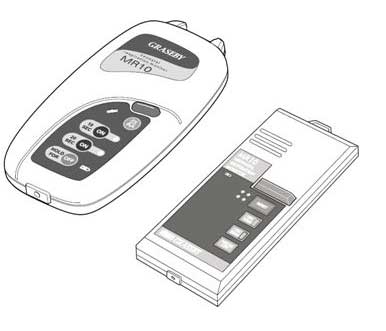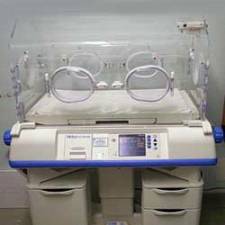Adult Monitoring - Obstructive Sleep Apnoea
 Portable monitoring (PM) refers to the diagnostic evaluation of obstructive sleep Apnoea-hypopnea (OSAH) outside of a conventional sleep laboratory. It has evolved as an alternative to polysomnography (PSG) because it is convenient, relatively accurate, and less costly. Polysomnography is a multi-parametric test used in the study of sleep and as a diagnostic tool in sleep medicine. The test result is called a polysomnogram, also abbreviated PSG. The name is derived from Greek and Latin roots: the Greek 'poly' for multi-channel (many), the Latin 'somnus' (sleep), and the Greek 'graphein' (to write).
Portable monitoring (PM) refers to the diagnostic evaluation of obstructive sleep Apnoea-hypopnea (OSAH) outside of a conventional sleep laboratory. It has evolved as an alternative to polysomnography (PSG) because it is convenient, relatively accurate, and less costly. Polysomnography is a multi-parametric test used in the study of sleep and as a diagnostic tool in sleep medicine. The test result is called a polysomnogram, also abbreviated PSG. The name is derived from Greek and Latin roots: the Greek 'poly' for multi-channel (many), the Latin 'somnus' (sleep), and the Greek 'graphein' (to write).
Fewer physiologic variables are measured during PM compared to PSG, but PM does not require a technologist to attend and can be performed in the patient's home or in a hospital room (including the intensive care unit). PM can be used with continuous positive airway pressure equipment (CPAP).
Four types of sleep study monitoring devices have been defined:
- Type 1 monitoring devices are used for in-laboratory, technician-attended, overnight polysomnography (PSG). These devices are not used for PM.
- Type 2 monitoring devices can record the same variables as type 1 devices. The major difference from Type 1 devices is that they can be used outside of the sleep laboratory and a technologist is not present during the recording.
- Type 3 monitoring devices do not record the signals needed to determine sleep stages or sleep disruption. Typically, four physiologic variables are measured including two respiratory variables (eg, respiratory movement and airflow), a cardiac variable (eg, heart rate or an electrocardiogram), and arterial oxyhemoglobin saturation. Some devices have additional signals that can detect snoring, determine body position, or detect movement. A technologist is not present during the recording.
- Type 4 monitoring devices are defined as devices that record one or two variables (eg, arterial oxyhemoglobin saturation and airflow) and can be used without a technician.
Sleep Apnoea in adults is becoming more prevalent, especially in obese adult patients. Many patient use continuous positive airway pressure non-invasive ventilation (CPAP) as sleep support devices.
Babies
After they're born, babies must breathe continuously to get oxygen. In a premature baby, the part of the central nervous system (brain and spinal cord) that controls breathing is not yet mature enough to allow nonstop breathing. This causes large bursts of breath followed by periods of shallow breathing or stopped breathing. The medical term for this is Apnoea of prematurity, or AOP. Once off a mechanical ventilator and breathing on their own - with or without nasal CPAP - they are monitored continuously for any evidence of Apnoea. The cardiorespiratory monitor (also known as an Apnoea and bradycardia, or A/B, monitor) also tracks the infant's heart rate. An alarm on the monitor sounds if there's no breath for a set number of seconds. When the monitor sounds, a nurse immediately checks the baby for signs of distress. False alarms are not uncommon.
If a baby doesn't begin to breathe again within 15 seconds, a nurse will rub the baby's back, arms, or legs to stimulate the breathing. Most of the time, babies with Apnoea of prematurity spells will begin breathing again on their own with this kind of stimulation.
Home monitoring
A home monitor is used to monitor babies who still have minor problems with breathing and heart rate. A baby is very rarely discharged home with a home Apnoea monitor. Those who may be sent home with such a machine include infants who have persistent Apnoea or severe reflux, a family history of Sudden infant death syndrome (SIDS), or who need home oxygen or a breathing machine.
Sensors will be attached to the baby's chest or stomach. A home nursing company usually teaches parents how to use the monitor, and provides support for the monitor as well. The length of time the monitor is needed depends on how many real alarms go off. The average length of home monitoring is about 2-3 months.
Monitors are electrical instruments that can fail when the power is out, or if there is some electrical problem. There is no risk to the baby in these cases. There may be some skin irritation from the stick-on electrodes, but this is usually mild.
Sudden infant death syndrome (SIDS) is a syndrome marked by the symptoms of sudden and unexplained death of an apparently healthy infant aged one month to one year. The term cot death is often used in the United Kingdom, Australia and New Zealand, while crib death is sometimes used in North America.
In human infants sleep develops rapidly during early development. This development includes an increase in non-rapid eye movement sleep (NREM sleep) which is also called Quiet Sleep (QS) during the first 12 months of life in association with a decrease in rapid eye movement sleep (REM sleep) which is also known as Active Sleep (AS) In addition, slow wave sleep (SWS) which consists of Stage 3 and Stage 4 NREM sleep appears at 2 months of age and it is theorized that some infants have a brain-stem defect which increases their risk of being unable to arouse from SWS (also called Deep Sleep) and therefore have an increased risk of SIDS due to their increased inability to arouse from SWS. In a currently used model that explains the process in which slow wave sleep is involved in memory consolidation the hippocampus acts as a temporary storage facility for new memories which are then transferred to the neocortex during slow wave sleep (SWS).
A home Apnoea monitor is a portable machine that may be used to monitor a baby's heart beat, breathing, or movement after coming home from the hospital. When the baby has a heart rate or breathing rate that is below the limits set on the monitor, an alarm goes off. The monitor is smaller and less complex than those used in the hospital.
 The MR10 is a single channel respiration monitor with a choice of a 10 or 20 second apnea delay. To work, the Monitor requires a Respiration Sensor. The Sensor is attached to the baby's abdomen and is linked to the Monitor by a narrow tube.
The MR10 is a single channel respiration monitor with a choice of a 10 or 20 second apnea delay. To work, the Monitor requires a Respiration Sensor. The Sensor is attached to the baby's abdomen and is linked to the Monitor by a narrow tube.
A breathing signal is picked up by the soft, foam filled Sensor (Respiration Sensor) attached to the infant's abdomen. During breathing, expansion of the abdominal wall causes a small amount of air to pass through the Sensor and tube to the Monitor. During breathing the Monitor will also make an audible click and give a simultaneous visual indication.
If the selected alarm time (20sec.) is breached (i.e. if no breath is detected after 20sec.) an audiovisual alarm is triggered. The Monitor is powered by 4 LR6 (AA) alkaline batteries. A low battery indicator is included on the main panel of the monitor. The MR10 has a battery life of up to 60 days.
Sources:
http://eecindia.tripod.com/apneaPF.htm
http://kidshealth.org/parent/pregnancy_newborn/medical_problems/aop.html
http://en.wikipedia.org/wiki/Apnoea_monitor
http://www.adhb.govt.nz/newborn/Pamphlets/HomeApnoeaAlarms.pdf
Compiled by: John Sandham IEng MIET MIHEEM




